Thermal Energy Elena
Download as pptx, pdf1 like960 views
Thermal energy is the energy transferred between bodies due to a temperature difference. It can come from natural sources like the sun or from human processes like burning fossil fuels. Fossil fuels like coal, oil, and natural gas are non-renewable sources of thermal energy that were formed over millions of years from the remains of ancient organisms. Coal is used for electricity production while oil and natural gas are used for transportation, manufacturing, heating and electricity generation.
1 of 20
Downloaded 14 times
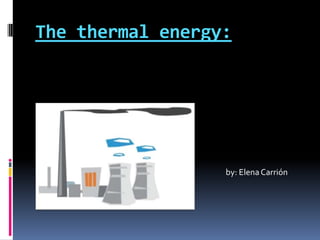
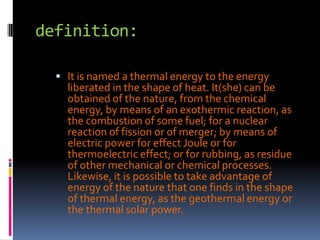
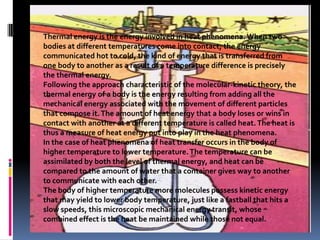

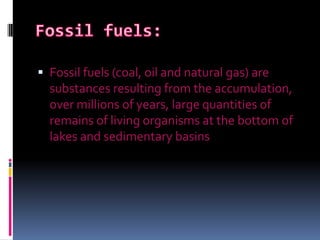
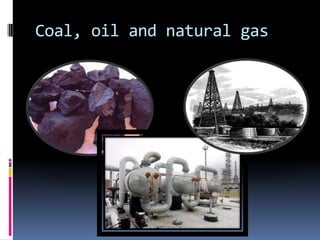

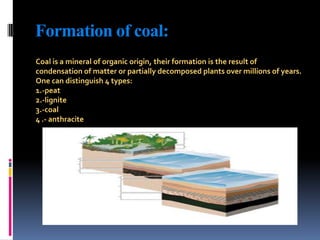
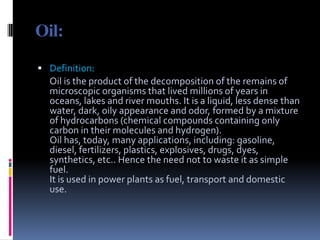

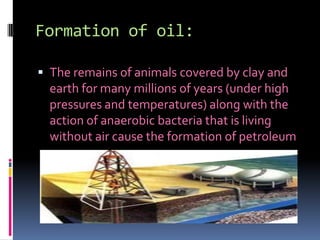
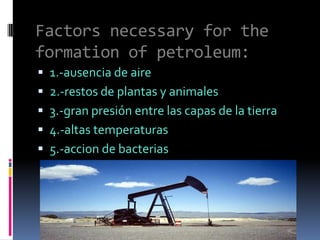
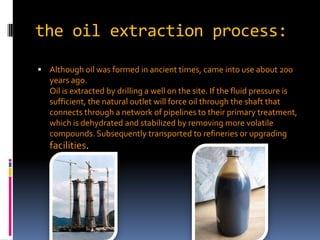

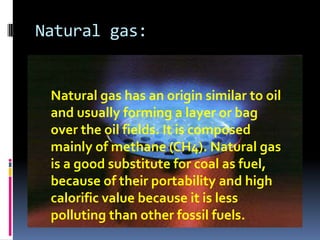
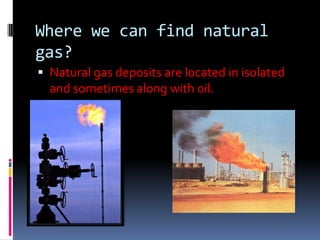
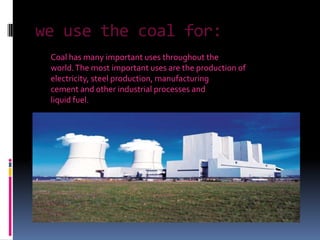
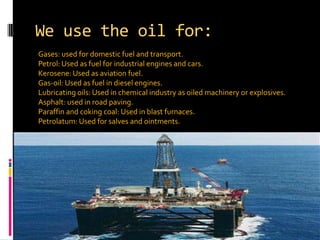
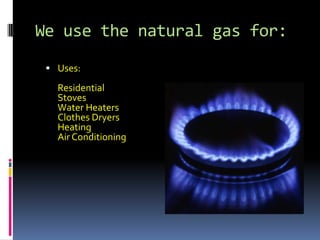

Ad
Recommended
Energy megalokonomos makris
Energy megalokonomos makrisVasso Servou
Ěý
The document discusses different types of energy sources including non-renewable sources like fossil fuels such as coal, oil, and natural gas as well as nuclear power. It also discusses renewable energy sources including solar, wind, hydropower, biomass, biofuels, and geothermal energy. It provides brief descriptions of each type of energy source and notes that over 85% of the world's energy currently comes from non-renewable sources.Fossil fuel
Fossil fuelAnithaDevi19
Ěý
Fossil fuels are non-renewable energy sources formed from the remains of ancient plants and animals. While cheap and abundant, fossil fuels cause environmental damage and health issues. Alternative fuels are renewable sources that can replace fossil fuels, such as biodiesel from vegetable oils, bioethanol from sugars and starches, and natural gas which burns more cleanly than other fossil fuels. Switching to alternative fuels addresses issues with fossil fuels like pollution, climate change, and relying on non-renewable resources.Energy resources
Energy resourcesAbdulMoizMemon1
Ěý
This document discusses different types of energy resources. It categorizes energy resources as renewable and non-renewable, and provides examples of each. Non-renewable resources like coal, oil, and natural gas were formed over millions of years from decayed plant and animal remains. These are finite and will eventually run out. Renewable resources like wind, solar, and hydropower can be replenished and will not run out. The document also discusses the formation and uses of key fossil fuels like coal and petroleum, as well as nuclear energy from uranium.Energy and natural resources
Energy and natural resourcesProf. A.Balasubramanian
Ěý
This document provides an overview of various energy sources in India, including both renewable and non-renewable sources. It discusses fossil fuels like coal, oil, and natural gas which currently provide most of India's energy but are limited. It also covers renewable sources like solar, biomass, wind, and biogas energy which have potential to meet more of India's future energy needs in a sustainable manner. The document aims to evaluate both conventional and alternative energy sources and conservation practices important for India's development and environmental protection.Renewable and nonrenewable resources
Renewable and nonrenewable resourcesKhaled alnajjar
Ěý
This document discusses the differences between nonrenewable and renewable resources. Nonrenewable resources such as coal, petroleum, natural gas and uranium cannot be replaced at the same rate at which they are consumed. Coal, petroleum and natural gas are fossil fuels that took millions of years to form. Nuclear energy uses uranium as a fuel through nuclear fission. Renewable resources such as solar, geothermal, wind, water and biomass can be naturally replenished at a sustainable rate through natural processes. Energy from the sun, heat from the Earth, wind, flowing water and burning organic matter are all considered renewable resources.Gas VS Geothermal
Gas VS GeothermalHawkesdale P12 College
Ěý
The document compares natural gas and geothermal energy in terms of formation, extraction, transport, usage, economic impacts, social implications, environmental effects, and contributions to greenhouse gas emissions. Natural gas is noted for being a cleaner fossil fuel, while geothermal energy has minimal greenhouse gas emissions but is less efficient for power transportation. The document also discusses international and national policies aimed at reducing greenhouse emissions and fostering sustainable energy practices.Energy
EnergyJnana Prabodhini Educational Resource Center
Ěý
Energy is required to do any work and can take various forms like light, heat, and electricity. The main source of energy is the sun, whose light energy gets converted into chemical energy by plants and stored in their bodies. Fossil fuels like coal, oil, and natural gas were formed from the remains of ancient plants and animals over millions of years underground and are a limited resource. As populations and industries grow, energy usage is increasing but fossil fuel sources are finite, so alternatives like solar, wind, hydro, and nuclear need to be developed and used more responsibly to address energy needs and environmental problems.Renewable & Nonrenewable Resources
Renewable & Nonrenewable ResourcesPaula Burrough
Ěý
Nonrenewable resources like coal, petroleum and natural gas cannot be replenished in a short period of time and will eventually run out. They were formed from ancient organisms millions of years ago. Renewable resources such as solar, wind, water and biomass can be naturally replenished in a short period of time through natural processes and are less finite than nonrenewable resources. The key difference between the two is whether the resource can be naturally replenished within human timescales.non-renewable and renewable resources
non-renewable and renewable resources singhsmita15
Ěý
This document discusses the differences between nonrenewable and renewable resources. Nonrenewable resources such as coal, petroleum, natural gas and uranium cannot be replaced at the same rate at which they are being used. Coal, petroleum and natural gas are fossil fuels that take millions of years to form. Uranium is used for nuclear energy but is limited. Renewable resources like solar, wind, water and biomass can be replenished naturally in a short period of time through natural processes.Natural gas
Natural gas SCIENCE PRODUCTIONS
Ěý
Natural gas is a mixture of light hydrocarbons extracted from deposits underground. It is a non-renewable fossil fuel formed over hundreds of millions of years as organic matter like plants and plankton were buried under sediment and rock. Natural gas is used for heating buildings and power generation, as well as in vehicles. It produces less pollution than oil or coal but is still a finite resource and its transportation and use contribute to greenhouse gas emissions and environmental impacts.Energy resources and conservation
Energy resources and conservationGodwin Michael
Ěý
This document discusses various energy resources and conservation. It begins by describing how early humans had minimal needs that were met by collecting food and shelter from forests. As humanity progressed, technologies developed and needs increased. The document then discusses the development of conventional energy sources like coal and petroleum, as well as non-conventional renewable sources like solar, wind, hydroelectric, geothermal, tidal, and biomass energy. It emphasizes that non-conventional sources are abundant, renewable, and don't cause pollution. In summary, the document provides an overview of humanity's changing energy use throughout history and discusses both conventional and non-conventional energy resources and their importance.Renewable and Nonrenewable Energy Resources
Renewable and Nonrenewable Energy ResourcesSamson Dsouza
Ěý
The document classifies energy resources into non-renewable and renewable categories, highlighting non-renewables like coal and oil as limited and environmentally harmful, while presenting renewables such as solar and hydroelectric power as abundant and sustainable. It discusses the pros and cons of each type, emphasizing the necessity of energy conservation due to rising costs and environmental impacts. The document concludes with a call for energy efficiency improvements through audits and custom solutions.Geothermal energy
Geothermal energye-twinning
Ěý
This document discusses geothermal energy in Poland and Tenerife. It notes that Poland has good conditions for geothermal energy from underground reservoirs between 30-130°C. Over 90% of Poland's heating comes from geothermal. Tenerife also has geothermal potential from an underground system at 275°C and already generates 42% of its electricity from wind. Geothermal can be used for individual home heating but initial costs are high. Benefits include renewable energy without emissions, stable power, and low operating costs. Drawbacks include limited areas where it can be effectively used and high initial costs.Grothermal energy Group 4
Grothermal energy Group 4e-twinning
Ěý
Geothermal energy is heat from below the Earth's surface that can be used to generate electricity or provide heating and cooling. This document summarizes geothermal energy use in Poland and Tenerife. In Poland, geothermal plants provide heating to cities like Zakopane and Pyrzyce. Tenerife has potential for geothermal energy given its volcanic history and underground hydrothermal systems with temperatures over 275 degrees Celsius. Current exploration projects aim to develop geothermal resources on Tenerife, Gran Canaria, and La Palma.Renewable and non renewable resources
Renewable and non renewable resourcesFiona Tonissen
Ěý
The document discusses the differences between nonrenewable and renewable resources. Nonrenewable resources like coal, petroleum, natural gas and uranium cannot be replaced rapidly as they are used up. Renewable resources such as solar, geothermal, wind, biomass and hydroelectric can be replenished naturally in a short period of time and do not get used up.1. World Energy
1. World EnergyJames Craig
Ěý
83-87
Hydrogen
10-14
Nitrogen
0.1-2
Oxygen
0.1-1.5
Sulphur
0.5-6
The document discusses various topics related to energy production and consumption including:
- Energy production has steadily increased worldwide from 215 quadrillion BTU in 1970 to 417 quadrillion BTU in 2003, a 94% rise.
- The top three energy producing countries in 2003 were United States, Russia, and China.
- Energy consumption is directly related to quality of life as measured by factors like life expectancy, education, and GDP.
- FossSources of Energy
Sources of Energyitutor
Ěý
The document discusses different sources of energy. It describes renewable energy sources like solar, wind, hydro, and biomass energy. It notes that renewable sources are sustainable but have inconsistencies based on weather. The document also covers non-renewable fossil fuels like coal, oil, and natural gas. Fossil fuels are abundant but finite, and their use contributes to pollution and climate change. Overall, the document provides an overview of various energy sources, both renewable and non-renewable. Ppt on energy resources
Ppt on energy resourcesManowara Chowdhury
Ěý
This document discusses various energy resources including conventional and non-conventional sources. Conventional sources like coal, petroleum and natural gas are exhaustible and cause pollution. Coal is formed from the compression of plant material and occurs in various forms depending on depth and pressure. Petroleum is formed from the remains of animals and plants compressed over millions of years. Natural gas is found associated with coal and petroleum deposits. Non-conventional sources like solar, wind, biomass, tidal, geothermal and nuclear energy are renewable, pollution-free and can help meet future energy demands. India has good potential in many non-conventional resources due to its long coastline and other geographical features.Energy resources
Energy resourcesDei Agra, India
Ěý
This document provides an overview of energy resources and conservation. It begins by defining energy and classifying resources as renewable and non-renewable. Fossil fuels like coal, oil and natural gas make up most of the world's energy consumption currently, though renewable sources like solar, wind and hydropower are growing. The document then discusses various non-renewable and renewable energy sources in more detail. It concludes by emphasizing the importance of energy conservation to use resources optimally and ensure availability for future generations.Renewable and non renewable resources
Renewable and non renewable resourcesSadia Zareen
Ěý
This document summarizes the key differences between nonrenewable and renewable resources. Nonrenewable resources such as coal, petroleum and natural gas cannot be replenished within human timescales, whereas renewable resources like solar, wind and hydropower can be regenerated naturally and quickly. The text provides examples of nonrenewable resources like uranium and fossil fuels that are finite, as well as renewable resources including solar, geothermal, wind, biomass and hydropower that can be sustainably used into the future.Geothermal energy - Poland & Tenerife
Geothermal energy - Poland & Tenerifee-twinning
Ěý
Geothermal energy is thermal energy generated and stored in the Earth. It is extracted through deep boreholes tapping into hot water or steam underground. Iceland generates over 90% of its home heating and electricity through geothermal energy. While geothermal potential is large, its use depends on specific geological conditions. Poland has begun developing geothermal energy projects like the Geotermia Podhalańska initiative providing heat to Zakopane hotels. Exploration is also underway on the Canary Islands like Tenerife to assess geothermal resource potential for sustainable energy development.Geothermal energy in Poland and Tenerife
Geothermal energy in Poland and Tenerifee-twinning
Ěý
Poland has good conditions for geothermal energy, as 80% of the country has underground water temperatures between 30-130 degrees C. However, geothermal energy currently only provides 0.03% of Poland's primary energy and is only used in six locations. The advantages of geothermal include being environmentally friendly and providing constant energy regardless of weather. The disadvantages are its low availability across the country, potential for pollution, and high upfront costs. Tenerife and Lanzarote are two Canary Islands well-suited for geothermal energy due to ideal underground conditions, though no plants currently operate there. Conventional & non conventional energy sources.
Conventional & non conventional energy sources.MaitriThakor
Ěý
This document presents information on conventional and non-conventional energy sources. Conventional sources include commercial sources like coal, oil, natural gas, and thermal power as well as non-commercial sources like firewood. These are exhaustible over time. Non-conventional sources discussed include solar energy, wind energy, tidal energy, geothermal energy, and biomass-based energy. These are renewable sources as they can be replenished relatively quickly through natural processes. The document provides details on each type of energy source, how they are harnessed or produced, and their usage and potential.Classification of energy
Classification of energySahil Gohad
Ěý
This document classifies and defines different types of energy sources. It discusses primary energy sources, which are harvested directly from nature, as well as secondary energy sources, which are derived from primary sources through technological processes. It also covers commercial energy sources, which are available for purchase; non-commercial sources, which are traditionally gathered; renewable sources, which are naturally replenished; and non-renewable sources, which are finite. Primary examples are provided for each energy classification.Energy resources
Energy resources pramodhhj
Ěý
Energy resources can be classified as conventional (firewood, coal, petroleum, natural gas, electricity) or non-conventional (solar, wind, tidal, geothermal, biogas, nuclear). Coal and petroleum are India's most abundant and widely used conventional resources, providing substantial energy needs, while non-conventional sources are increasingly important to ensure future energy security and reduce environmental impacts.Resources renewable and non renewable
Resources renewable and non renewableKella Randolph
Ěý
The document evaluates renewable and non-renewable energy resources in North Carolina, highlighting the environmental issues and technological alternatives associated with each. It emphasizes the distinct characteristics and uses of various non-renewable resources such as fossil fuels, minerals, and their impact on health and the ecosystem, while also detailing the potential of renewable energy sources like solar and wind. Additionally, it provides links for further research and emphasizes the importance of informed decision-making regarding energy consumption and production.Energy resources
Energy resourcesShweta Saraswat
Ěý
The document summarizes different types of energy resources, separating them into renewable and non-renewable categories. Renewable resources like sunlight, wind, water, and biomass can be replenished within a human lifespan. Non-renewable resources such as fossil fuels and ores are finite, as they take thousands of years to form. The document also discusses alternative energy sources including solar, wind, hydropower, nuclear, and biomass that provide more environmentally friendly options compared to fossil fuels.Energy resources
Energy resourcesMukuldev Khunte
Ěý
This document defines energy resources as anything that can be used as a source of energy, such as oil and natural gases. It outlines that there are two types of energy resources: non-renewable resources like coal, oil, and natural gases, and renewable resources like biomass, solar, and wind. Energy resources are further divided into conventional resources and alternative resources. The document also notes global consumption of energy sources is mostly non-renewable at 82% compared to 18% renewable.Cambridge IGCSE Chemistry 0654 Chapter 6 Chemical energetics
Cambridge IGCSE Chemistry 0654 Chapter 6 Chemical energeticsaryanpatel3532
Ěý
Cambridge IGCSE Chemistry 0654 Chapter 6 Chemical energeticsFOSSIL FUELS: TYPES, FACTS, ADV & DIS ADV AND CALORIFIC VALUE
FOSSIL FUELS: TYPES, FACTS, ADV & DIS ADV AND CALORIFIC VALUERaswanth Senthil
Ěý
Fossil fuels are natural fuels formed from the remains of dead plants and animals over millions of years. The three main types are coal, petroleum, and natural gas. Coal forms from dead plant matter and is a solid fossil fuel. Petroleum, or crude oil, forms from dead marine organisms and is a liquid fossil fuel. Natural gas forms in the same way and is composed primarily of methane. Fossil fuels are non-renewable and provide most of the world's energy but also contribute greatly to greenhouse gas emissions and global warming.More Related Content
What's hot (20)
non-renewable and renewable resources
non-renewable and renewable resources singhsmita15
Ěý
This document discusses the differences between nonrenewable and renewable resources. Nonrenewable resources such as coal, petroleum, natural gas and uranium cannot be replaced at the same rate at which they are being used. Coal, petroleum and natural gas are fossil fuels that take millions of years to form. Uranium is used for nuclear energy but is limited. Renewable resources like solar, wind, water and biomass can be replenished naturally in a short period of time through natural processes.Natural gas
Natural gas SCIENCE PRODUCTIONS
Ěý
Natural gas is a mixture of light hydrocarbons extracted from deposits underground. It is a non-renewable fossil fuel formed over hundreds of millions of years as organic matter like plants and plankton were buried under sediment and rock. Natural gas is used for heating buildings and power generation, as well as in vehicles. It produces less pollution than oil or coal but is still a finite resource and its transportation and use contribute to greenhouse gas emissions and environmental impacts.Energy resources and conservation
Energy resources and conservationGodwin Michael
Ěý
This document discusses various energy resources and conservation. It begins by describing how early humans had minimal needs that were met by collecting food and shelter from forests. As humanity progressed, technologies developed and needs increased. The document then discusses the development of conventional energy sources like coal and petroleum, as well as non-conventional renewable sources like solar, wind, hydroelectric, geothermal, tidal, and biomass energy. It emphasizes that non-conventional sources are abundant, renewable, and don't cause pollution. In summary, the document provides an overview of humanity's changing energy use throughout history and discusses both conventional and non-conventional energy resources and their importance.Renewable and Nonrenewable Energy Resources
Renewable and Nonrenewable Energy ResourcesSamson Dsouza
Ěý
The document classifies energy resources into non-renewable and renewable categories, highlighting non-renewables like coal and oil as limited and environmentally harmful, while presenting renewables such as solar and hydroelectric power as abundant and sustainable. It discusses the pros and cons of each type, emphasizing the necessity of energy conservation due to rising costs and environmental impacts. The document concludes with a call for energy efficiency improvements through audits and custom solutions.Geothermal energy
Geothermal energye-twinning
Ěý
This document discusses geothermal energy in Poland and Tenerife. It notes that Poland has good conditions for geothermal energy from underground reservoirs between 30-130°C. Over 90% of Poland's heating comes from geothermal. Tenerife also has geothermal potential from an underground system at 275°C and already generates 42% of its electricity from wind. Geothermal can be used for individual home heating but initial costs are high. Benefits include renewable energy without emissions, stable power, and low operating costs. Drawbacks include limited areas where it can be effectively used and high initial costs.Grothermal energy Group 4
Grothermal energy Group 4e-twinning
Ěý
Geothermal energy is heat from below the Earth's surface that can be used to generate electricity or provide heating and cooling. This document summarizes geothermal energy use in Poland and Tenerife. In Poland, geothermal plants provide heating to cities like Zakopane and Pyrzyce. Tenerife has potential for geothermal energy given its volcanic history and underground hydrothermal systems with temperatures over 275 degrees Celsius. Current exploration projects aim to develop geothermal resources on Tenerife, Gran Canaria, and La Palma.Renewable and non renewable resources
Renewable and non renewable resourcesFiona Tonissen
Ěý
The document discusses the differences between nonrenewable and renewable resources. Nonrenewable resources like coal, petroleum, natural gas and uranium cannot be replaced rapidly as they are used up. Renewable resources such as solar, geothermal, wind, biomass and hydroelectric can be replenished naturally in a short period of time and do not get used up.1. World Energy
1. World EnergyJames Craig
Ěý
83-87
Hydrogen
10-14
Nitrogen
0.1-2
Oxygen
0.1-1.5
Sulphur
0.5-6
The document discusses various topics related to energy production and consumption including:
- Energy production has steadily increased worldwide from 215 quadrillion BTU in 1970 to 417 quadrillion BTU in 2003, a 94% rise.
- The top three energy producing countries in 2003 were United States, Russia, and China.
- Energy consumption is directly related to quality of life as measured by factors like life expectancy, education, and GDP.
- FossSources of Energy
Sources of Energyitutor
Ěý
The document discusses different sources of energy. It describes renewable energy sources like solar, wind, hydro, and biomass energy. It notes that renewable sources are sustainable but have inconsistencies based on weather. The document also covers non-renewable fossil fuels like coal, oil, and natural gas. Fossil fuels are abundant but finite, and their use contributes to pollution and climate change. Overall, the document provides an overview of various energy sources, both renewable and non-renewable. Ppt on energy resources
Ppt on energy resourcesManowara Chowdhury
Ěý
This document discusses various energy resources including conventional and non-conventional sources. Conventional sources like coal, petroleum and natural gas are exhaustible and cause pollution. Coal is formed from the compression of plant material and occurs in various forms depending on depth and pressure. Petroleum is formed from the remains of animals and plants compressed over millions of years. Natural gas is found associated with coal and petroleum deposits. Non-conventional sources like solar, wind, biomass, tidal, geothermal and nuclear energy are renewable, pollution-free and can help meet future energy demands. India has good potential in many non-conventional resources due to its long coastline and other geographical features.Energy resources
Energy resourcesDei Agra, India
Ěý
This document provides an overview of energy resources and conservation. It begins by defining energy and classifying resources as renewable and non-renewable. Fossil fuels like coal, oil and natural gas make up most of the world's energy consumption currently, though renewable sources like solar, wind and hydropower are growing. The document then discusses various non-renewable and renewable energy sources in more detail. It concludes by emphasizing the importance of energy conservation to use resources optimally and ensure availability for future generations.Renewable and non renewable resources
Renewable and non renewable resourcesSadia Zareen
Ěý
This document summarizes the key differences between nonrenewable and renewable resources. Nonrenewable resources such as coal, petroleum and natural gas cannot be replenished within human timescales, whereas renewable resources like solar, wind and hydropower can be regenerated naturally and quickly. The text provides examples of nonrenewable resources like uranium and fossil fuels that are finite, as well as renewable resources including solar, geothermal, wind, biomass and hydropower that can be sustainably used into the future.Geothermal energy - Poland & Tenerife
Geothermal energy - Poland & Tenerifee-twinning
Ěý
Geothermal energy is thermal energy generated and stored in the Earth. It is extracted through deep boreholes tapping into hot water or steam underground. Iceland generates over 90% of its home heating and electricity through geothermal energy. While geothermal potential is large, its use depends on specific geological conditions. Poland has begun developing geothermal energy projects like the Geotermia Podhalańska initiative providing heat to Zakopane hotels. Exploration is also underway on the Canary Islands like Tenerife to assess geothermal resource potential for sustainable energy development.Geothermal energy in Poland and Tenerife
Geothermal energy in Poland and Tenerifee-twinning
Ěý
Poland has good conditions for geothermal energy, as 80% of the country has underground water temperatures between 30-130 degrees C. However, geothermal energy currently only provides 0.03% of Poland's primary energy and is only used in six locations. The advantages of geothermal include being environmentally friendly and providing constant energy regardless of weather. The disadvantages are its low availability across the country, potential for pollution, and high upfront costs. Tenerife and Lanzarote are two Canary Islands well-suited for geothermal energy due to ideal underground conditions, though no plants currently operate there. Conventional & non conventional energy sources.
Conventional & non conventional energy sources.MaitriThakor
Ěý
This document presents information on conventional and non-conventional energy sources. Conventional sources include commercial sources like coal, oil, natural gas, and thermal power as well as non-commercial sources like firewood. These are exhaustible over time. Non-conventional sources discussed include solar energy, wind energy, tidal energy, geothermal energy, and biomass-based energy. These are renewable sources as they can be replenished relatively quickly through natural processes. The document provides details on each type of energy source, how they are harnessed or produced, and their usage and potential.Classification of energy
Classification of energySahil Gohad
Ěý
This document classifies and defines different types of energy sources. It discusses primary energy sources, which are harvested directly from nature, as well as secondary energy sources, which are derived from primary sources through technological processes. It also covers commercial energy sources, which are available for purchase; non-commercial sources, which are traditionally gathered; renewable sources, which are naturally replenished; and non-renewable sources, which are finite. Primary examples are provided for each energy classification.Energy resources
Energy resources pramodhhj
Ěý
Energy resources can be classified as conventional (firewood, coal, petroleum, natural gas, electricity) or non-conventional (solar, wind, tidal, geothermal, biogas, nuclear). Coal and petroleum are India's most abundant and widely used conventional resources, providing substantial energy needs, while non-conventional sources are increasingly important to ensure future energy security and reduce environmental impacts.Resources renewable and non renewable
Resources renewable and non renewableKella Randolph
Ěý
The document evaluates renewable and non-renewable energy resources in North Carolina, highlighting the environmental issues and technological alternatives associated with each. It emphasizes the distinct characteristics and uses of various non-renewable resources such as fossil fuels, minerals, and their impact on health and the ecosystem, while also detailing the potential of renewable energy sources like solar and wind. Additionally, it provides links for further research and emphasizes the importance of informed decision-making regarding energy consumption and production.Energy resources
Energy resourcesShweta Saraswat
Ěý
The document summarizes different types of energy resources, separating them into renewable and non-renewable categories. Renewable resources like sunlight, wind, water, and biomass can be replenished within a human lifespan. Non-renewable resources such as fossil fuels and ores are finite, as they take thousands of years to form. The document also discusses alternative energy sources including solar, wind, hydropower, nuclear, and biomass that provide more environmentally friendly options compared to fossil fuels.Energy resources
Energy resourcesMukuldev Khunte
Ěý
This document defines energy resources as anything that can be used as a source of energy, such as oil and natural gases. It outlines that there are two types of energy resources: non-renewable resources like coal, oil, and natural gases, and renewable resources like biomass, solar, and wind. Energy resources are further divided into conventional resources and alternative resources. The document also notes global consumption of energy sources is mostly non-renewable at 82% compared to 18% renewable.Similar to Thermal Energy Elena (20)
Cambridge IGCSE Chemistry 0654 Chapter 6 Chemical energetics
Cambridge IGCSE Chemistry 0654 Chapter 6 Chemical energeticsaryanpatel3532
Ěý
Cambridge IGCSE Chemistry 0654 Chapter 6 Chemical energeticsFOSSIL FUELS: TYPES, FACTS, ADV & DIS ADV AND CALORIFIC VALUE
FOSSIL FUELS: TYPES, FACTS, ADV & DIS ADV AND CALORIFIC VALUERaswanth Senthil
Ěý
Fossil fuels are natural fuels formed from the remains of dead plants and animals over millions of years. The three main types are coal, petroleum, and natural gas. Coal forms from dead plant matter and is a solid fossil fuel. Petroleum, or crude oil, forms from dead marine organisms and is a liquid fossil fuel. Natural gas forms in the same way and is composed primarily of methane. Fossil fuels are non-renewable and provide most of the world's energy but also contribute greatly to greenhouse gas emissions and global warming.Fossil fuels
Fossil fuels Kandati Kusuma
Ěý
This document discusses fossil fuels, including coal, oil, and natural gas. It explains that fossil fuels are formed from the remains of ancient organisms over millions of years. Coal forms from buried plants, oil forms from small sea creatures and algae, and natural gas forms from phytoplankton and zooplankton. These fossil fuels are burned to generate electricity by heating water to create steam that spins turbines connected to generators. While fossil fuels provide inexpensive energy, their combustion also emits pollutants like carbon dioxide and contributes to issues like global warming.Fossil fuels and Alternate sources of energy.pptx
Fossil fuels and Alternate sources of energy.pptxNicoleMavi
Ěý
Fossil fuels, like coal, oil, and natural gas, are non-renewable energy sources formed from the remains of ancient organisms, and their combustion releases greenhouse gases, contributing to climate change and air pollution. Tecnologia
Tecnologiamanu_angela_2a
Ěý
This document provides definitions and information about different types of energy, including mechanical, electrical, thermal, electromagnetic, chemical, nuclear, and sound energy. It also discusses renewable energy sources like tidal, hydroelectric, wind, solar, and biomass energy, as well as non-renewable sources like fossil fuels and nuclear energy. The document then covers environmental impacts of energy production like acid rain and global warming. It concludes by briefly describing different types of power stations and discussing an innovative wind turbine design that can produce potable water from humid air.Tecnologia
Tecnologiamanu_angela_2a
Ěý
This document provides definitions and information about different types of energy, including mechanical, electrical, thermal, electromagnetic, chemical, nuclear, and sound energy. It also discusses renewable energy sources like tidal, hydroelectric, wind, solar, and biomass energy, as well as non-renewable sources like fossil fuels and nuclear energy. The document then covers environmental impacts of energy production like acid rain and global warming. It concludes by briefly describing different types of power stations and discussing an innovative wind turbine design that can produce potable water from humid air.Sources of energy
Sources of energyAbhishek Bhatia
Ěý
Energy can be obtained from various sources and is divided into conventional and non-conventional sources. Conventional sources include fossil fuels like coal, petroleum and natural gas, which were formed from the remains of ancient plants and animals but are being depleted. Non-conventional sources include renewable energy from solar, wind, and hydroelectric power. Fossil fuels are a non-renewable source and their combustion causes air and water pollution and global warming, so they must be used judiciously and alternatives developed.Fossil Fuels
Fossil Fuelsdwinter1
Ěý
Fuels provide energy through a process of energy transformation called combustion. The three major fossil fuels are coal, oil, and natural gas. Fossil fuels are nonrenewable resources that were formed over millions of years from the remains of ancient organisms. While fossil fuels provide a large amount of the energy used today, they are being consumed faster than they are produced, so new energy sources will be needed to replace decreasing fossil fuel reserves.Sources of energy
Sources of energyMayank Sharma
Ěý
We have already know that energy is the capacity of a body to do work. There are two main types of energy sources: natural sources like solar, wind, and hydro energy which are obtained directly from nature; and synthetic sources like batteries which are man-made. Fossil fuels like coal, oil and natural gas are considered non-renewable resources as they take millions of years to form from the remains of ancient plants and animals. Petroleum, in particular, is a naturally occurring liquid found beneath the earth's surface that is refined into fuels like gasoline. It consists of hydrocarbon remains of ancient microscopic organisms that lived hundreds of millions of years ago.1. Energy Engineering
1. Energy Engineering Adib Bin Rashid
Ěý
ME-181 is an introductory course to mechanical engineering. It discusses various topics related to energy including mechanical energy, electrical energy, electromagnetic energy, and chemical energy. It also discusses different energy sources such as conventional sources like fossil fuels and non-conventional sources including solar energy, wind energy, biomass energy, tidal energy, geothermal energy, and nuclear energy. Fossil fuels like coal, petroleum, and natural gas are discussed in detail including their formation and impact. Different fuel types including solid, liquid, and gaseous fuels are also summarized.COAL AND PETROLEUM.pptx
COAL AND PETROLEUM.pptxbhavygarg7636
Ěý
Coal and petroleum are two examples of fossil fuels that are formed over millions of years from the remains of ancient plants and animals. Coal is a solid fuel that is an important source of energy, while petroleum is a liquid found underground that is refined into fuels like gasoline and diesel. Both coal and petroleum are non-renewable resources that must be conserved, as destructive distillation of coal and fractional distillation of petroleum produce valuable fuels and products, but alternatives should be pursued so these limited resources last as long as possible.Natural Resources-Power From the Environment
Natural Resources-Power From the EnvironmentVinay Parikh
Ěý
Natural resources are raw materials provided by the Earth, classified into biotic (living) and abiotic (non-living) categories, and include renewable resources like solar and wind energy, and non-renewable resources such as fossil fuels. Examples of biotic resources include plants and animals, while abiotic resources consist of minerals and metals. The document discusses the significance, classification, and various forms of natural resources, including their implications for energy production and environmental impact.Energy Presentation
Energy PresentationLauraCorchero
Ěý
This document provides information about different types of energy sources. It defines energy and discusses various forms of energy including mechanical, electrical, electromagnetic, sound, chemical, nuclear, and thermal energy. It also describes renewable energy sources like hydraulic, solar, wind, marine, geothermal, and biomass. Non-renewable sources like coal, petroleum, and natural gas are examined. Finally, it analyzes different types of power stations including hydraulic, solar, nuclear, and thermal.Chapter 5- earths resources
Chapter 5- earths resourcesSteven_iannuccilli
Ěý
This document provides information about various energy and mineral resources on Earth. It discusses how fossil fuels like coal, oil and natural gas are formed from the remains of ancient organisms over millions of years and are being used faster than they can be replenished. Renewable resources like solar, wind, water, and geothermal energy are also introduced. The document outlines different processes used to extract and utilize these various resources.Non Renewable energy resources description.
Non Renewable energy resources description.conqueror8367
Ěý
A non-renewable resource is a natural resource, such as oil, coal, and natural gas, that does not replenish quickly after consumption, taking millions of years to form. These resources are essential for energy production but are finite and can contribute to environmental harm and global warming. To ensure sustainability, it is important to reduce reliance on non-renewable resources and increase the use of renewable energy sources like solar and wind power.Renewable and non renewable energy.ppt
Renewable and non renewable energy.pptasustuf4
Ěý
The document explains the difference between renewable and non-renewable energy sources. Renewable energy is derived from natural sources that are abundant and environmentally friendly, such as solar, wind, and geothermal energy, while non-renewable energy comes from finite resources like fossil fuels and nuclear energy, which have harmful environmental impacts. The document also discusses the greenhouse effect caused by emissions from burning fossil fuels and highlights the importance of transitioning to renewable energy sources.Main energy resources
Main energy resources86praveen
Ěý
The document discusses various renewable and non-renewable energy sources including coal, crude oil, natural gas, oil shale, peat, hydropower, biomass, solar energy, geothermal energy, wind energy, and nuclear energy. It provides brief descriptions of each source, noting whether they are renewable or non-renewable. Methods for obtaining and using different renewable sources like hydropower, biomass, solar, geothermal, and wind energy are outlined.Renewable non-renewable-energy-resources
Renewable non-renewable-energy-resourcesRachit Walia
Ěý
Renewable and non-renewable energy resources and the importance of energy conservation are discussed. Renewable resources include solar, wind, hydroelectric, geothermal, and biofuels which can be replenished. Non-renewable resources like coal, oil and gas are limited and their extraction causes environmental damage. Conservation of energy through efficient use and recycling is emphasized to reduce pollution and delay depletion of non-renewable resources.renewable-non-renewable-energy-resources-110308030738-phpapp02.pptx
renewable-non-renewable-energy-resources-110308030738-phpapp02.pptxFrancis de Castro
Ěý
Here are the energy resources identified as renewable or non-renewable:
1. Biomass - Renewable
2. Hydropower - Renewable
3. Oil - Non-renewable
4. Natural Gas - Non-renewable
5. Geothermal Energy - Renewable
6. Coal - Non-renewable
7. Wind energy - Renewable
8. Solar Energy - Renewable
9. Nuclear Energy - Non-renewable
10.Fossil Fuel - Non-renewableGeography vocabulary bbc bitesize
Geography vocabulary bbc bitesizeAlmudena AlegrĂa
Ěý
The document defines over 50 terms related to geography, climate change, and the environment. Some key terms include:
- Adaptation: Actions taken to avoid or deal with the impacts of climate change through planning or in response to changes.
- Aerosol: Tiny solid or liquid particles in the atmosphere from natural or human sources that can warm or cool the climate.
- Atmosphere: The layer of gases surrounding Earth that supports life through processes like photosynthesis.
- Carbon dioxide: A colorless, odorless greenhouse gas produced by decay, respiration, and burning fossil fuels. Increased levels are the main cause of global warming.
- Climate change: Significant long-term shifts in weather patterns and other climate factorsAd
More from Rosalmara (14)
Science presentation 1 st day
Science presentation 1 st dayRosalmara
Ěý
Natural Science is a subject that can make you discover the world around you. You will learn many interesting things, and the teacher is sure you will love it. The document outlines the teachers, materials needed, course contents organized by term and unit, classroom behavior rules, assessment criteria broken down by content and attitude, how attitude and notebooks will be evaluated, and an initial student evaluation.Biomass mÂŞeugenia y marina
Biomass mÂŞeugenia y marinaRosalmara
Ěý
Biomass refers to organic material from plants and animals that can be used as an energy source. Through photosynthesis, plants absorb solar energy and convert it into chemical energy stored in biomass. Biomass is a renewable resource and includes materials such as agricultural waste, wood, and algae. It can be burned directly for heat and electricity or processed into biofuels like ethanol. The use of biomass has advantages like being renewable and storing energy, but also has disadvantages like competing with food production and having high costs.Biomass Marina
Biomass MarinaRosalmara
Ěý
Biomass is any organic material from plants or animals that can be used as an energy source. Biomass forms through photosynthesis, which uses solar energy to produce high-energy chemical compounds in living matter. Biomass resources include forestry and agricultural wastes as well as energy crops grown specifically for energy production. Biomass has advantages as a renewable resource that stores energy and can be converted flexibly with low environmental impact, but also has disadvantages like competition for land use and higher costs than fossil fuels.Biomass MÂŞEugenia
Biomass MÂŞEugeniaRosalmara
Ěý
Biomass is organic material from plants and animals that can be used as an energy source. Through photosynthesis, plants absorb solar energy and convert it into chemical energy stored in biomass. Biomass is a renewable resource as new plants regrow, and includes waste from agriculture, forestry, and municipalities. Common biomass fuels include ethanol from crops, biodiesel from vegetable oils, and methane from composting organic waste. While biomass has significant potential as an energy source, many countries like Spain are not fully utilizing their biomass resources.Photovoltaic Solar Energy Alicia
Photovoltaic Solar Energy AliciaRosalmara
Ěý
Solar energy is gained by capturing light and heat from the sun and is considered a renewable energy source. There are several types of solar energy including passive solar, solar thermal, solar thermoelectric, solar hybrid, solar wind, and photovoltaic solar energy. Photovoltaic solar energy involves the use of solar panels to convert sunlight directly into electricity through photovoltaic cells. Spain is currently one of the largest producers of photovoltaics in the world.Solar Thermal Energy Isabel
Solar Thermal Energy IsabelRosalmara
Ěý
Solar thermal energy systems harness solar energy as heat. There are three main types of solar thermal collectors: low-temperature collectors heat swimming pools, medium-temperature collectors heat water for homes and businesses, and high-temperature collectors concentrate sunlight to produce electricity or process heat. Heat from collectors is transferred using fluids like water or glycol and can be stored for later use through thermal mass materials or molten salts. Common solar thermal applications include water heating, space heating, drying crops and materials, and generating electricity through technologies like parabolic troughs and power towers.Nuclear Power Guillermo
Nuclear Power GuillermoRosalmara
Ěý
This document discusses nuclear energy and provides details about nuclear fission and fusion processes. It notes that nuclear energy is obtained through fission and fusion and describes how fission in nuclear reactors works to generate heat and then electricity. It also addresses both the advantages of nuclear energy in providing power while emitting low pollution as well as the dangers of radiation exposure.Wave Energy Pedro Zambrana
Wave Energy Pedro ZambranaRosalmara
Ěý
The document discusses the design of an electrical oscillating machine for harvesting wave energy. It proposes a cylindrical ballasted machine design that allows relative movement between electrical circuit housing bodies. This design has advantages over conventional devices like increased robustness, watertightness, simple construction, and lower unit costs. In conclusion, the cylindrical ballasted machine design outperforms conventional wave energy harvesting devices as it does not require an energy converter.Geothermal Energy Sonia
Geothermal Energy SoniaRosalmara
Ěý
Geothermal energy is heat from within the Earth that can be used for energy. It comes from the Greek words for earth ("geo") and hot ("thermos"). Geothermal energy exists in different temperatures ranges and can be used to generate electricity via steam turbines or directly in geothermal heat pumps for heating and cooling. While a renewable source of energy, geothermal reservoirs can become depleted if not carefully managed through water reinjection.Tidal Energy Victor
Tidal Energy VictorRosalmara
Ěý
Tidal energy harnesses the power of tides by using turbines that are turned by the flow of water into and out of estuaries during high and low tides. It is a renewable source of energy that does not produce pollutants. While tidal energy does not emit greenhouse gases, it can only be harvested in specific locations where the tide differential is greater than 5 meters, and the high upfront costs and potential environmental impacts have limited its widespread adoption.Nuclear Power Taja
Nuclear Power TajaRosalmara
Ěý
Nuclear energy comes from nuclear fission or fusion reactions that release huge amounts of energy used to produce electricity. Nuclear fission occurs when an atom splits into smaller parts, releasing energy. Nuclear fusion is the collision of light nuclei to form heavier nuclei, also releasing energy. Nuclear power plants typically use uranium-235 as fuel and have four main parts: the reactor, steam generator, turbine, and condenser. Accidents are possible but rare, with only two major accidents occurring at Three Mile Island and Chernobyl. Nuclear energy provides advantages as well as risks from radioactive waste and potential accidents.Hydraulic Energy Patricia
Hydraulic Energy PatriciaRosalmara
Ěý
Hydraulic energy is obtained from the kinetic and potential energy of rivers, waterfalls, and tides. It is a renewable green energy as long as environmental impacts are minimal. Water is essential to our planet and has potential as a renewable energy source. Water is used in hydroelectric power plants, which exploit the potential energy of water flowing downhill. These plants come in different types - run-of-river, reservoir, and pumped storage - but all work by passing water through turbines to generate electricity. Hydropower is renewable, produces no pollution, and provides a significant amount of electricity in many countries.Wind Power
Wind PowerRosalmara
Ěý
The wind is caused by uneven heating of the Earth's surface by the sun, which causes differences in air pressure. Between 1-2% of the sun's energy is transformed into wind. Wind power is a renewable energy source that does not produce emissions or pollutants. Spain is a global leader in wind power, with over 11,000 MW of installed capacity in 2006, making it the second largest producer in the world at that time. Wind power has advantages of being renewable and clean but also has disadvantages like difficulty in production forecasting and needing transmission lines to transport electricity from remote wind farms.Tutorial BlogsRosalmara
Ěý
Este documento presenta las herramientas TIC y su uso en orientaciĂłn educativa. Explica cĂłmo crear y administrar un blog de orientaciĂłn, usar Google Docs y plataformas educativas, e invitar a otros miembros del equipo a participar y colaborar mediante estas herramientas. El objetivo es mejorar la comunicaciĂłn, proporcionar recursos e informaciĂłn Ăştiles, y fomentar la innovaciĂłn y el trabajo en equipo.Ad
Thermal Energy Elena
- 1. The thermal energy:by: Elena CarriĂłn
- 2. definition:It is named a thermal energy to the energy liberated in the shape of heat. It(she) can be obtained of the nature, from the chemical energy, by means of an exothermic reaction, as the combustion of some fuel; for a nuclear reaction of fission or of merger; by means of electric power for effect Joule or for thermoelectric effect; or for rubbing, as residue of other mechanical or chemical processes. Likewise, it is possible to take advantage of energy of the nature that one finds in the shape of thermal energy, as the geothermal energy or the thermal solar power.
- 3. Thermal energy is the energy involved in heat phenomena. When two bodies at different temperatures come into contact, the energy communicated hot to cold, the kind of energy that is transferred from one body to another as a result of a temperature difference is precisely the thermal energy. Following the approach characteristic of the molecular-kinetic theory, the thermal energy of a body is the energy resulting from adding all the mechanical energy associated with the movement of different particles that compose it. The amount of heat energy that a body loses or wins in contact with another at a different temperature is called heat. The heat is thus a measure of heat energy put into play in the heat phenomena. In the case of heat phenomena of heat transfer occurs in the body of higher temperature to lower temperature. The temperature can be assimilated by both the level of thermal energy, and heat can be compared to the amount of water that a container gives way to another to communicate with each other. The body of higher temperature more molecules possess kinetic energy that may yield to lower body temperature, just like a fastball that hits a slow speeds, this microscopic mechanical energy transit, whose combined effect is the heat be maintained while those not equal.
- 4. Not renewable energies:The thermal energy is classified as non-renewable energy, which means that it is not forever and there are 3 heat sources: 1) Coal 2) Natural gas 3) Oil
- 5. Fossil fuels:Fossil fuels (coal, oil and natural gas) are substances resulting from the accumulation, over millions of years, large quantities of remains of living organisms at the bottom of lakes and sedimentary basins
- 6. Coal, oil and natural gas
- 7. The coal:Composition: Itis formed in nature by the decomposition of residual plant material accumulated in swamps ol large riversComprised mainly of carbon but also contains hydrogen, oxygen and nitrogen varying amounts of sulfur and other
- 8. Formation of coal:Coal is a mineral of organic origin, their formation is the result of condensation of matter or partially decomposed plants over millions of years.One can distinguish 4 types:1.-peat2.-lignite3.-coal4 .- anthracite
- 9. Oil:Definition: Oil is the product of the decomposition of the remains of microscopic organisms that lived millions of years in oceans, lakes and river mouths. It is a liquid, less dense than water, dark, oily appearance and odor, formed by a mixture of hydrocarbons (chemical compounds containing only carbon in their molecules and hydrogen).Oil has, today, many applications, including: gasoline, diesel, fertilizers, plastics, explosives, drugs, dyes, synthetics, etc.. Hence the need not to waste it as simple fuel.It is used in power plants as fuel, transport and domestic use.
- 10. Composition of oil: Oil is a heterogeneous mixture where coexisting solids, liquid and gas. This consists of compounds called hydrocarbons, which are composed of two elements:A.- carbonB.-hydrogen
- 11. Formation of oil:The remains of animals covered by clay and earth for many millions of years (under high pressures and temperatures) along with the action of anaerobic bacteria that is living without air cause the formation of petroleum
- 12. Factors necessary for the formation of petroleum:1.-ausencia de aire2.-restos de plantas y animales3.-gran presiĂłn entre las capas de la tierra4.-altas temperaturas5.-accion de bacterias
- 13. the oil extraction process:Although oil was formed in ancient times, came into use about 200 years ago.Oil is extracted by drilling a well on the site. If the fluid pressure is sufficient, the natural outlet will force oil through the shaft that connects through a network of pipelines to their primary treatment, which is dehydrated and stabilized by removing more volatile compounds. Subsequently transported to refineries or upgrading facilities.
- 14. Petroleum refining:Oil, as extracted from the deposit, has no practical application whatsoever. it is therefore necessary to separate it into different factions that if they are useful. this process is done in the refineries. A refinery is an industrial facility where crude oil is transformed into useful products for people
- 15. Natural gas:Natural gas has an origin similar to oil and usually forming a layer or bag over the oil fields. It is composed mainly of methane (CH4). Natural gas is a good substitute for coal as fuel, because of their portability and high calorific value because it is less polluting than other fossil fuels.
- 16. Where we can find natural gas?Natural gas deposits are located in isolated and sometimes along with oil.
- 17. we use the coal for: Coal has many important uses throughout theworld. The most important uses are the production ofelectricity, steel production, manufacturingcement and other industrial processes andliquid fuel.
- 18. We use the oil for:Gases: used for domestic fuel and transport.Petrol: Used as fuel for industrial engines and cars.Kerosene: Used as aviation fuel.Gas-oil: Used as fuel in diesel engines.Lubricating oils: Used in chemical industry as oiled machinery or explosives.Asphalt: used in road paving.Paraffin and coking coal: Used in blast furnaces.Petrolatum: Used for salves and ointments.
- 19. We use the natural gas for:Uses:ResidentialStovesWater HeatersClothes DryersHeatingAir Conditioning
